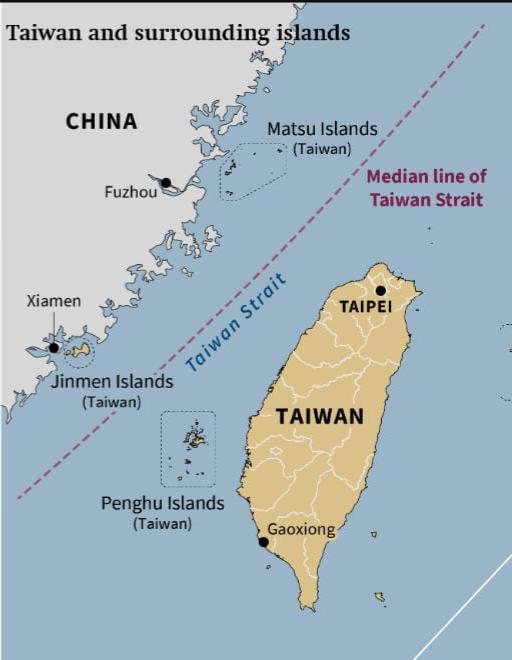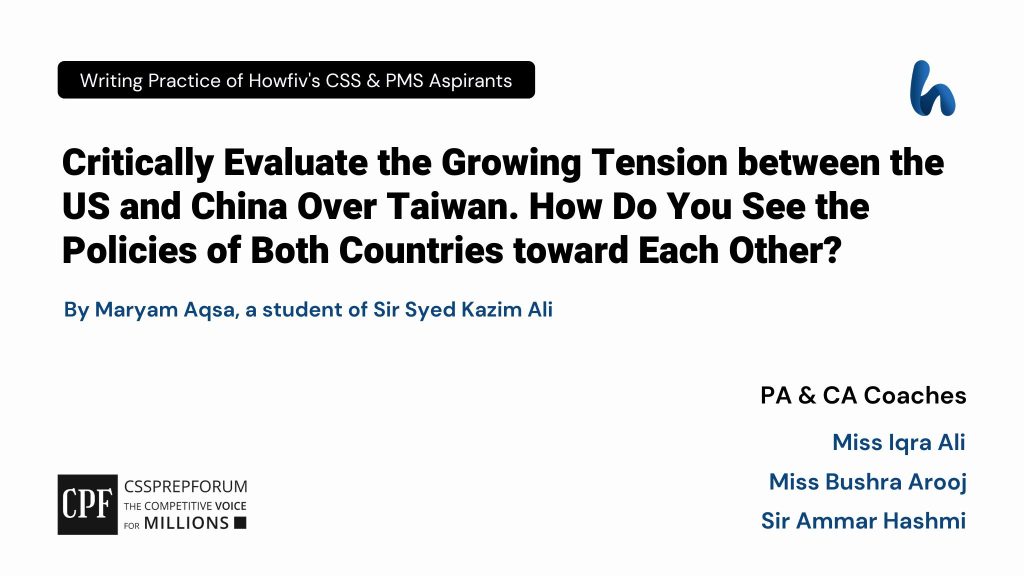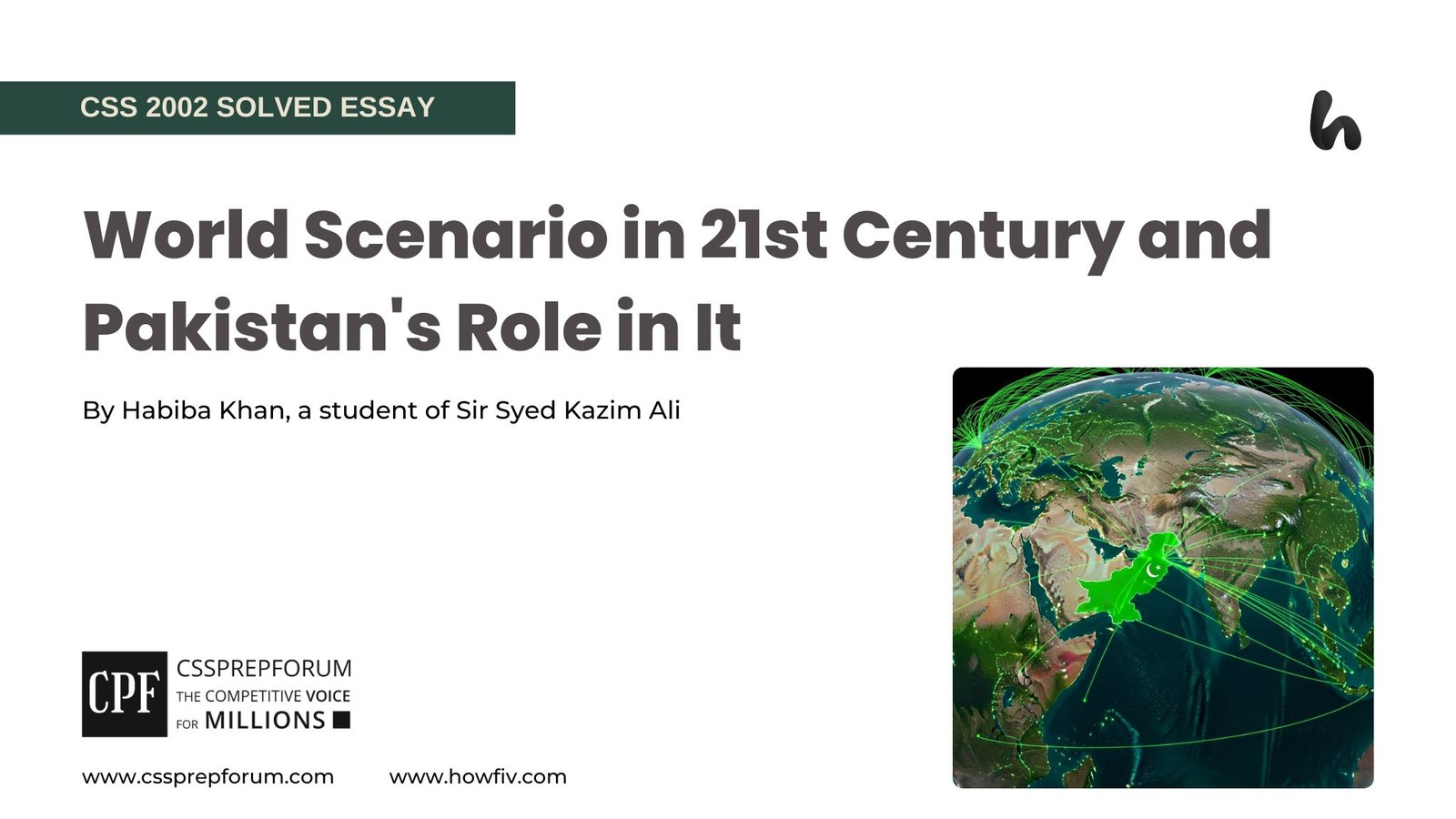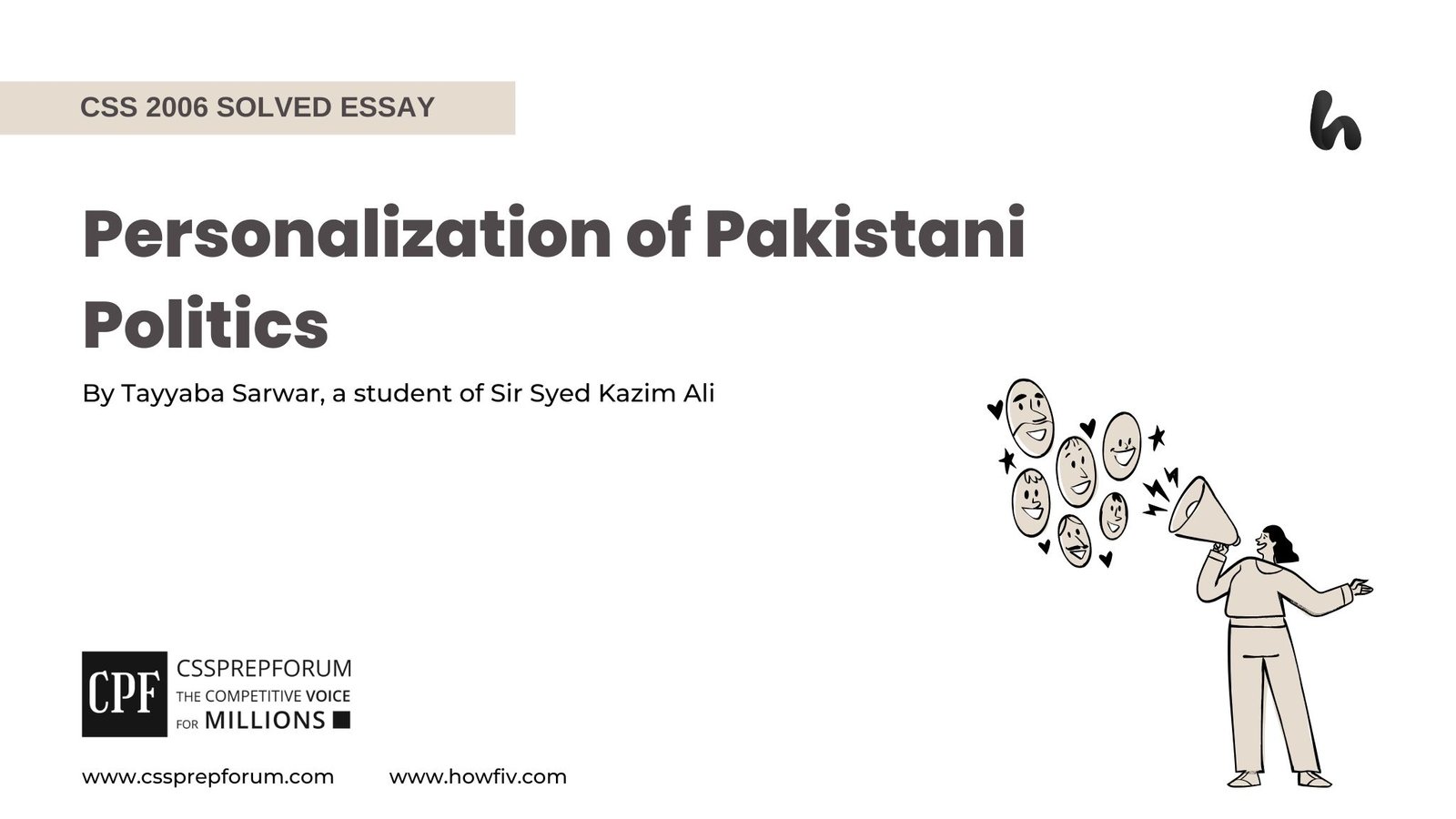CSS Current Affairs | Growing Tensions between US and China Over Taiwan
The following question of CSS Current Affairs is solved by Maryam Aqsa under the supervision of Howfiv’s Pakistan Affairs and Current Affairs Coaches. She learnt how to attempt 20 marks question and essay writing from Sir Syed Kazim Ali, Pakistan’s best CSS and PMS English essay and precis teacher with the highest success rate of his students. This solved past paper question is attempted on the pattern taught by Sir to his students, scoring the highest marks in compulsory and optional subjects for years, and uploaded to help aspirants understand how to crack a topic or question, how to write relevantly, what coherence is, and how to include and connect ideas, opinions, and suggestions to score the maximum.

Outline
1-Introduction
2-Geography of Taiwan and its importance for the US and China
3-Critically evaluate US-China growing tension over Taiwan
- ✓ One China policy
- ✓ Two China policy
- ✓ Control maritime route
- ✓ Weapon import by USA
- ✓ Technological research and development
4-Analysis of the policies of the US and China towards each other
4.1-Policies from the US towards China
- ✓ Spreading democratic government
- ✓ Struggling to create barriers to China trade
- ✓ Creating a threat to China’s sovereignty and economic stability
4.2-Policies from China towards the US
- ✓ Reunification with Taiwan
- ✓ Control of the South China Sea
- ✓ Stop to US technological resources
5-Conclusion

Answer to the Question
Introduction
Taiwan is a significant point of contention between China and the United States. Both countries are vying for influence over Taiwan for their purposes. The U.S. supports Taiwan’s democratic government, making them strong trade partners. Taiwan is home to some of the world’s leading technology companies, and the U.S. often sends its mobile chips there for research and development. Consequently, Taiwan’s independence is crucial for the U.S., which supports Taiwan and counters China’s policies. On the other hand, China claims that Taiwan is part of its territory. Despite sharing a common culture, historical conflicts have led to different ideologies between the two regions. China is striving to reclaim Taiwan to secure its maritime transit routes and reduce the influence of the U.S. in the region. China and the U.S. aim to control Taiwan to diminish the other’s influence and expand their territory. Meanwhile, Taiwan considers itself an independent country. This controversy remains unresolved, with no clear solution in sight.
Geography of Taiwan and its importance for the US and China

Taiwan is located 130 km from China, historically, it has been part of China. Later, Japan occupied the area and used soldiers from the Republic of China in World War II. As a result, Taiwan mixes Chinese and Japanese cultures, but its political ideologies align more with the USA. Apart from its strategic location, Taiwan is rich in natural resources like copper, gold, marble, limestone, gas, and coal. The island is also renowned for technological advancements, particularly in semiconductor research and development. Many U.S. companies rely on Taiwan for chip production, and China uses the maritime routes near Taiwan for trade. Taiwan is an independent country with its constitution, government, and flag. However, only 15 small countries officially recognize Taiwan as a separate state. The USA does not officially recognize Taiwan as an independent state but supports Taiwan’s democratic government and leverages its technological advancements. This support is part of a broader strategy to counter China’s influence and potentially disrupt the maritime routes China uses for trade with Europe.
How critically evaluate US-China growing tension over Taiwan
- One China policy
China claims Taiwan based on historical ties, viewing it as a breakaway province. However, Taiwan operates as an independent state with its government, constitution, and military. The United States follows a “strategic ambiguity” policy regarding Taiwan, adhering to the “One China” policy while simultaneously supporting Taiwan’s defence capabilities through arms sales and unofficial diplomatic relations.
- Two China policy
China has communism, while Taiwan is a democratic country. Both countries deny collaboration with each other. China desires reunification with Taiwan; contrarily, Taiwan rejects the statement. Taiwan has a separate flag and opposite ideologies to China- a democratic government in Taiwan with an independent constitution. Globally, only 15 small countries accept China as an independent state. In the USA context, the state supports Taiwan’s democratic government for their own profit.
- Control maritime route
Taiwan is located 130 km from China. By the statement of reunification, China controls the South China Sea. The South China Sea is full of natural resources—oil, gas, and aquatic animals—and plays a vital role in global trade. Conflicts are ongoing in the sea with other countries—Japan, the Philippines, and the USA. Moreover, China desires to secure its maritime route through Taiwan, while Taiwan claims that the straits of Taiwan are the boundary between China and Taiwan.
- Weapon import by USA
The USA has an arms factory, and weapons run large parts of the state economy. That is, the USA always supports rival countries and supplies weapons. Unfortunately, Taiwan is one of them. The USA favours Taiwan and escalates into a significant conflict in regional and global power. A military conflict over Taiwan could destabilize the region and have far-reaching implications for international security and the balance of power.
- Technological research and development
The United States leverages Taiwan’s technological research and development capabilities, particularly in the semiconductor industry, where Taiwan Semiconductor Manufacturing Company (TSMC) plays a crucial role in providing advanced chips essential for various technologies. By engaging in joint R&D projects, integrating Taiwan’s manufacturing capabilities into supply chains, investing in Taiwan’s tech sector, and facilitating talent exchange. Maleeha Lodhi highlights in her article the U.S. secures a steady supply of high-tech components and fosters innovation in fields like AI, 5G, and biotechnology. These collaborations enhance the U.S.’s technological edge and strengthen the strategic partnership between the two nations amid growing competition with China.
Analysis of the policies of the US and China towards each other
A-Policies from the US towards China
- Spreading democratic government
The United States supports Taiwan in maintaining the balance of power in the Asia Pacific region and countering the influence of China’s military and economy. Hafeez Pasha mentioned in his writing, “A stable and secure Taiwan contributes to regional stability, which is crucial for global trade and economic interests.” By standing with Taiwan, the U.S. enhances its global influence and demonstrates its role as a defender of democratic values and international norms. This support helps the U.S. maintain its leadership position in the international community.
- Struggling to create barriers to China’s trade
China used to use a maritime route, passing near Taiwan Straits. China considers the U.S. could impose targeted economic sanctions on Chinese shipping companies or critical sectors, restricting their ability to operate freely. That is, China spread its territory through the Belt and Road route, going from China to Europe easily. By this route, China secured trade channels from the US and enhanced its friendship worldwide.
- Creating a threat to China’s sovereignty and economic stability
China examined Taiwan as an open source for the United States to attack China. The United States could threaten China’s sovereignty and economic stability through military, economic, diplomatic, and technological measures. These could include increasing military presence and alliances in the Asia-Pacific region, imposing targeted sanctions and export controls on vital Chinese industries, conducting assertive freedom of navigation operations, building international coalitions to isolate China diplomatically, leveraging human rights issues to rally global condemnation, and supporting Taiwan militarily and diplomatically. While these actions could disrupt China’s strategic ambitions and economic growth, they carry significant risks of escalating tensions and triggering broader geopolitical and financial instability.
B-Policies from China towards the US
- Reunification with Taiwan
China seeks to reunify with Taiwan primarily due to historical, national identity, and political legitimacy reasons, viewing Taiwan as an integral part of its territory that must be reclaimed. Strategically, reunification would bolster China’s control over vital maritime routes and enhance its regional influence, while economically, it would integrate Taiwan’s advanced technology and skilled workforce, boosting China’s technological capabilities. Domestically, promoting reunification with Taiwan serves as a national goal for the Chinese Communist Party, fostering domestic stability and rallying support among the populace. These factors clarify China’s efforts to reunify with Taiwan despite international complexities and challenges.
- Control of the South China Sea
China aims to control the South China Sea to assert its geopolitical influence, secure strategic maritime routes, and provide access to valuable natural resources such as oil and gas. By establishing control over this critical waterway, China aims to strengthen its military presence, protect its maritime borders, and assert its territorial claims based on historical narratives like the “Nine-Dash Line”. This control also serves as a strategic response to perceived challenges to its sovereignty, including competing claims from neighbouring countries and international naval activities, solidifying China’s position as a prominent regional power in the Asia-Pacific region.
- Stop to US technological resources
Energetically, China has focused on mitigating its reliance on U.S. technological resources due to national security concerns, strategic competition, and economic independence goals. This effort includes accelerating domestic innovation and research, particularly in critical sectors like semiconductors and telecommunications. To mitigate vulnerabilities, China’s is stemming from potential U.S. export controls and intellectual property restrictions. By bolstering technological self-sufficiency, China aims to enhance its global competitiveness, safeguard national interests, and assert greater autonomy in international relations amid ongoing geopolitical tensions with the United States.
Conclusion
The U.S. and China have a complicated relationship highlighted by deep economic interdependence and significant strategic rivalry. The U.S. target is to counterbalance China’s rising influence and support Taiwan’s democratic governance, while China seeks to assert its sovereignty claims and expand its global influence. Both countries’ policies reflect a mix of competition, deterrence, and selective cooperation, particularly in areas of mutual interest like climate change and global health. The ongoing tensions over Taiwan remain a critical flashpoint with the potential to escalate into broader conflict if not managed carefully.

CSS Solved Past Papers’ Essays
Looking for the last ten years of CSS and PMS Solved Essays and want to know how Sir Kazim’s students write and score the highest marks in the essays’ papers? Then, click on the CSS Solved Essays to start reading them.
CSS Solved Essays
CSS Solved Islamiyat Past Papers
Want to read the last ten years’ Islamiyat Solved Past Papers to learn how to attempt them and to score high? Let’s click on the link below to read them all freely. All past papers have been solved by Pakistan’s top CSS Islamiyat coach having the highest score of their students.
CSS Solved Islamiyat
CSS Solved General Science & Ability Past Papers
Want to read the last ten years’ General Science & Ability Solved Past Papers to learn how to attempt them and to score high? Let’s click on the link below to read them all freely. All past papers have been solved by Pakistan’s top CSS GSA coach having the highest score of their students.
CSS Solved General Science & Ability












